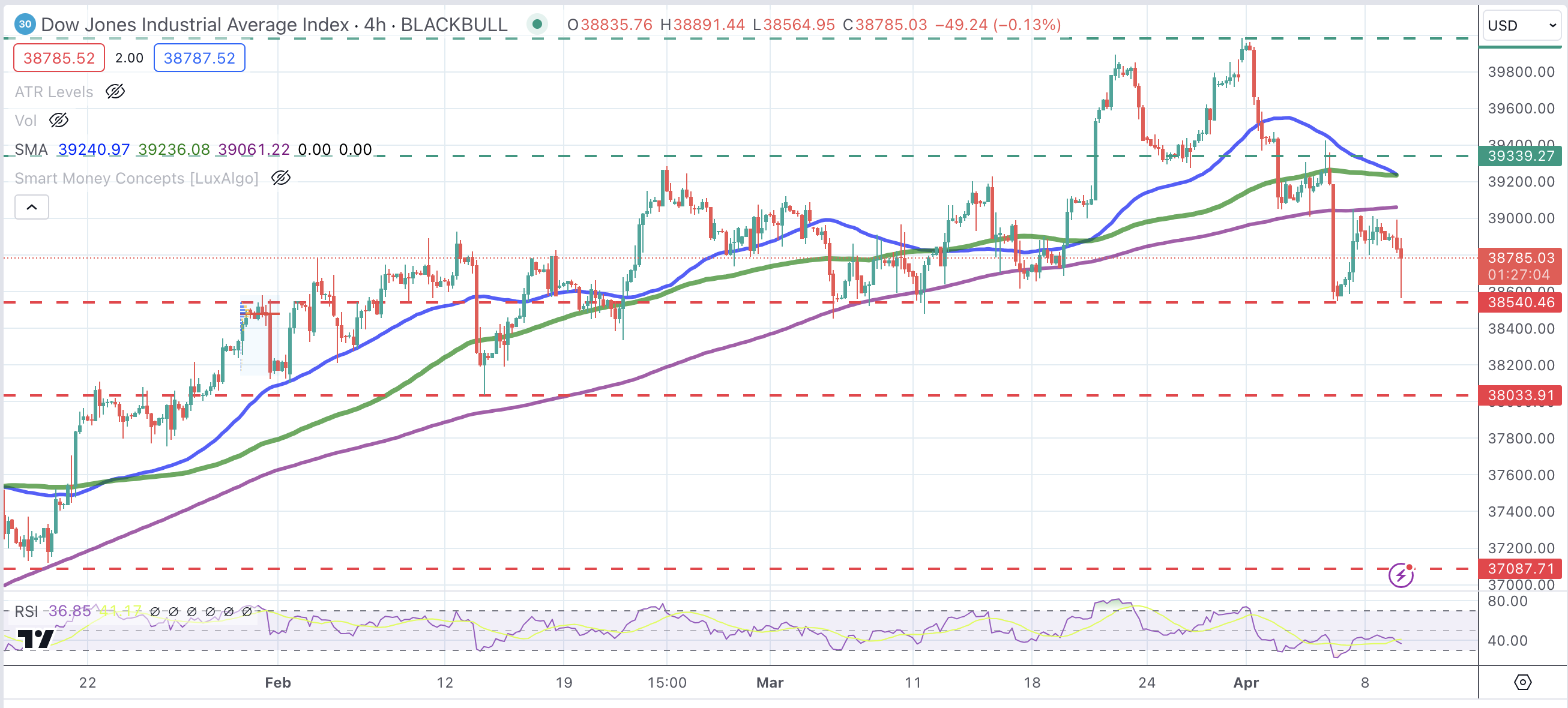Dow Jones Industrial Average drops further with US inflation on focus

- Wall Street turns lower with investors turning cautious ahead of US CPI release.
- US inflation is expected to show mixed readings with levels well above the Fed’s 2% core target rate.
- The Dow Jones Index has found support at 38,540, although broader bias remains negative.
The Dow Jones Industrial Average (DJIA) has dropped into negative territory during Tuesday’s US morning session. The moderate risk appetite seen during the European trading session has waned in the US, with investors taking a cautious stance ahead of Tuesday’s US CPI release.
US Consumer Inflation is expected to have accelerated to 3.4% in March from the 3.2% annual rate in February. The core CPI, which scraps the impact of seasonal food and energy prices, is estimated to ease to 3.7% from a 3.8% annual reading for February. In any case, showing levels well above the Federal Reserve’s (Fed) 2% core inflation rate for price stability.
The cautious market mood has sent all the main Wall Street indices lower on Tuesday, although they are pulling back from session lows at the moment of writing. The Dow Jones drops 0.34% to 38,760, followed by the S&P 500, which is 0.25% down to 5,186 and the NASDAQ Index, less than 0.1% lower to 16,238.
Dow Jones news
Among sectors, the Financials are getting the biggest blow with a 0.71% loss, followed by the Industrials, 0.5% lower, and Energu, dropping another 0.5%. Real Estate is the only sector showing a significant advance, up 0.7%, while Utilities and Consumer Staples and Consumer Discretionary post marginal gains.
Travelers Companies (TRV) is the worst-performing stock in the Dow Jones, losing 2.3% to $225.28, followed by American Express (AXP) which is down 1.8% to $219.83. The biggest winners are Cisco Systems (CSCO), up 2.79%, to $49.59, and 3M (MMM), advancing 1.23% to $93.06.
Dow Jones technical outlook
The technical picture shows the Dow Jones index picking up after having tested the support area at 38,540. The broader trend, however, remains bearish with the pair correcting lower from March highs near 40,000.
A further decline below 38,540 would expose February’s low at 38,035. On the upside, the pair should breach the 39,340 resistance area to break the negative price structure and open the path toward the all-time high at 39,985.
Dow Jones Index 4-Hour Chart
S&P 500 FAQs
The S&P 500 is a widely followed stock price index which measures the performance of 500 publicly owned companies, and is seen as a broad measure of the US stock market. Each company’s influence on the computation of the index is weighted based on market capitalization. This is calculated by multiplying the number of publicly traded shares of the company by the share price. The S&P 500 index has achieved impressive returns – $1.00 invested in 1970 would have yielded a return of almost $192.00 in 2022. The average annual return since its inception in 1957 has been 11.9%.
Companies are selected by committee, unlike some other indexes where they are included based on set rules. Still, they must meet certain eligibility criteria, the most important of which is market capitalization, which must be greater than or equal to $12.7 billion. Other criteria include liquidity, domicile, public float, sector, financial viability, length of time publicly traded, and representation of the industries in the economy of the United States. The nine largest companies in the index account for 27.8% of the market capitalization of the index.
There are a number of ways to trade the S&P 500. Most retail brokers and spread betting platforms allow traders to use Contracts for Difference (CFD) to place bets on the direction of the price. In addition, that can buy into Index, Mutual and Exchange Traded Funds (ETF) that track the price of the S&P 500. The most liquid of the ETFs is State Street Corporation’s SPY. The Chicago Mercantile Exchange (CME) offers futures contracts in the index and the Chicago Board of Options (CMOE) offers options as well as ETFs, inverse ETFs and leveraged ETFs.
Many different factors drive the S&P 500 but mainly it is the aggregate performance of the component companies revealed in their quarterly and annual company earnings reports. US and global macroeconomic data also contributes as it impacts on investor sentiment, which if positive drives gains. The level of interest rates, set by the Federal Reserve (Fed), also influences the S&P 500 as it affects the cost of credit, on which many corporations are heavily reliant. Therefore, inflation can be a major driver as well as other metrics which impact the Fed decisions.
